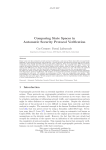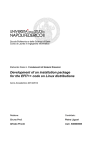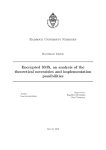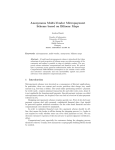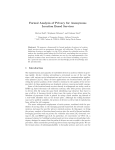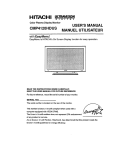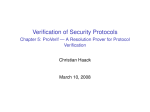Download Spi2Java User Manual - Version 3.1
Transcript
Spi2Java User Manual - Version 3.1
Alfredo Pironti, Davide Pozza, Riccardo Sisto
Politecnico di Torino
Dipartimento di Automatica e Informatica
C.so Duca degli Abruzzi, 24
10129 - Torino - Italy
Disclaimer: Please consider that the Spi2Java framework is a research prototype. It has not undergone all testing and validation that is usually expected
for a production environment software. We are already conscious of some of
its deficiencies and possible improvements. Please feel free to contact us by
email if you encounter or find any problem. Feedbacks and suggestions are very
appreciated. When you contact us, please write to all of us
{alfredo.pironti,riccardo.sisto}@polito.it
and use “Spi2Java” as a prefix in the subject. We will answer as soon as possible.
License: Creative Commons Attribution-ShareAlike. For license details
please see: http://creativecommons.org/licenses/by-sa/3.0/legalcode
1
Contents
1 Introduction
3
2 Getting Started with Spi2Java
2.1 Prerequisites . . . . . . . . . . . . . . . . . . . . . . . . . . . . .
2.2 Getting the Software and Setting It Up . . . . . . . . . . . . . .
3
3
3
3 Spi
3.1
3.2
3.3
3.4
Calculus and Reference Example
Term Syntax . . . . . . . . . . . . .
Process Syntax . . . . . . . . . . . .
Spi Calculus Source Files Syntax . .
An Example . . . . . . . . . . . . . .
.
.
.
.
.
.
.
.
.
.
.
.
.
.
.
.
.
.
.
.
4
4
5
8
8
4 Spi2Java Development Methodology and Tool Support
4.1 Writing and Compiling the Formal Model . . . . . . . . .
4.2 Hints for the Formal Verification Step . . . . . . . . . . .
4.3 Refining the Formal Model . . . . . . . . . . . . . . . . .
4.3.1 Theory . . . . . . . . . . . . . . . . . . . . . . . .
4.3.2 Practice . . . . . . . . . . . . . . . . . . . . . . . .
4.4 Implementing the Java Application . . . . . . . . . . . . .
4.4.1 Obtaining a protocol prototype implementation . .
4.4.2 Customizing the Encoding Layer . . . . . . . . . .
4.5 Adding Custom eSpi Types . . . . . . . . . . . . . . . . .
.
.
.
.
.
.
.
.
.
.
.
.
.
.
.
.
.
.
.
.
.
.
.
.
.
.
.
.
.
.
.
.
.
.
.
.
11
11
13
13
13
21
25
26
29
30
.
.
.
.
.
.
.
.
.
.
.
.
.
.
.
.
.
.
.
.
.
.
.
.
.
.
.
.
.
.
.
.
.
.
.
.
.
.
.
.
.
.
.
.
5 Spi2Java Auxiliary Tools
30
5.1 Typer by Default . . . . . . . . . . . . . . . . . . . . . . . . . . . 30
5.2 eSpi Merger . . . . . . . . . . . . . . . . . . . . . . . . . . . . . . 31
5.3 Spi2Proverif . . . . . . . . . . . . . . . . . . . . . . . . . . . . . . 31
2
1
Introduction
Formal methods have the potential to significantly improve the trustworthiness
of critical software, especially when development turns out to be intrinsically
error prone, and bugs difficult to discover, as it happens with cryptographic
protocols. However, one of the problems that still limit the widespread use of
formal methods is the high level of expertise that they normally require and the
high cost of development that their use implies. A way to partially overcome
the above problem and to improve the acceptance and productivity of formal
methods is to provide methodologies and tools that simplify the use of formal
methods, introducing automation and hiding underlying complexity.
Spi2Java is a set of tools that support a model-based approach to cryptographic protocol implementation based on the spi calculus [1]. By using these
tools it is possible to take advantage of the capabilities of high-level formal analysis tools such as ProVerif[2] and S 3 A[3], while at the same time ensuring the
correspondence between high level formal models and their implementations.
In short, the main Spi2Java tools and their aims are as follows:
spi calculus parser is a pre-processor and parser for the spi calculus description of the protocol.
spi2java refiner is a type checker that infers Java types for the spi calculus
terms used in the (untyped) protocol description.
spi2java code generator is an automatic code generator that emits the Java
code implementing the protocol described in spi calculus.
The rest of this document is organized as follows. Section 2 specifies system requirements for running the Spi2Java framework and explains how to get
started with it. Section 3 introduces the spi calculus language with the syntax accepted by the tools and presents a reference example that will be used
throughout this document. Section 4 shows in detail, mainly through the full
development of the reference example, how the tools can be used to produce
an implementation of a cryptographic protocol. Section 5 explains how to use
some correlated auxiliary tools.
2
2.1
Getting Started with Spi2Java
Prerequisites
The Spi2Java tools are entirely implemented in Java. For this reason, a Java
Runtime Environment version 1.6.x or later is required to run the tools composing the framework.
An Apache Ant version 1.7.x or later build.xml script is provided, in order
to compile the tools from sources or to perform other distribution-related tasks.
However, Apache Ant (and the Java SDK) is not needed for the typical user, as
the distribution includes ready-to-use executable jar files.
2.2
Getting the Software and Setting It Up
You should have downloaded a copy of the framework, which includes this user
manual, from the Spi2Java web site, at http://spi2java.polito.it/
3
The framework comes in a compressed archive, either in tar.gz or in zip
format. Whatever archive you downloaded, extract it; it will create a new
directory containing the extracted content.
Please take a look at the README file: it contains general information on the
framework, and a description of the files included in the distribution.
No other installation steps are required. In particular, as this user manual is
concerned, the jars directory contains all pre-compiled jars. Those containing
a tui in their name are the executable jars, providing a “textual user interface”
(also known as cli – “command line interface”) to the Spi2Java tools. In general,
on a UNIX platform, assuming that the JARS environment variable points to
the jars directory of the Spi2Java framework, you can run one of the tools by
invoking the following command from the command line:
java -jar $JARS/<jar filename.jar> [options]
All programs support a -h option that prints an help screen and exits, and
a -debug option that enables debugging mode, with extensive error reporting,
useful for troubleshooting or bug reporting.
3
Spi Calculus and Reference Example
The spi calculus is defined in [1] as an extension of the π calculus [4] with cryptographic primitives. It is a process algebraic language designed for describing
and analyzing cryptographic protocols. These protocols heavily rely on cryptography and on message exchange through communication channels; accordingly,
the Spi-Calculus provides powerful primitives to express cryptography and communication.
This section illustrates the spi calculus syntax accepted by the framework
and describes the language semantics informally.
The language used by Spi2Java is basically the spi calculus as defined in [1]
with some extensions. The syntax has been slightly modified with respect to [1],
in order to make it machine-readable
A spi calculus specification is a system of independent processes, executing in
parallel; they synchronize via message-passing through named communication
channels. The spi calculus has two basic language elements: terms, to represent
data, and processes, to represent behaviors.
3.1
Term Syntax
Terms can be either atomic elements, i.e. names, including the special name 0
representing the integer constant zero, and variables, or compound terms built
using the term composition operators listed in Tab. 1. Names can represent for
example communication channels, atomic keys, key pairs, nonces (also called
fresh names) and any other unstructured data.
The informal meaning of the term composition operators is as follows:
• (σ, ρ) is the pairing of σ and ρ. It is a compound term whose components
are σ and ρ. Pairs can always be freely split into their components.
• suc(σ) is the successor of σ. This operator has been introduced mainly to
represent successors over integers, but it can be used, more generally, as
the logical successor of any term.
4
σ, ρ ::=
m
x
(σ, ρ)
0
suc(σ)
H(σ)
σ∼
{σ}ρ
σ+
σ−
{[σ]}ρ
[{σ}]ρ
terms
name
variable
pair
zero
successor
hashing
shared-key
shared-key encryption
public part
private part
public-key encryption
private-key encryption (signature)
Table 1: Term syntax of Spi-Calculus
• H(σ) is the hashing of σ. H(σ) represents a function of σ that cannot be
inverted.
• Term σ∼ represents a shared key obtained by some key material σ.
• Term {σ}ρ is the ciphertext obtained by encrypting σ under key ρ using
a shared-key cryptosystem.
• σ+ and σ− represent respectively the public and private half of a key pair
σ. σ+ cannot be deduced from σ− and vice versa.
• {[σ]}ρ is the result of the public-key encryption of σ with ρ.
• [{σ}]ρ is the result of the signature (private key encryption) of σ with the
private key ρ.
In addition to the basic term composition operators shown in Tab. 1, some
syntactic shortcuts are available for common combinations of term compositions:
• (σ1 , σ2 , · · · , σn ) is a shortcut for the left-associated nested pairs (· · · ((σ1 , σ2 ), σ3 ), · · · ), σn ).
• any unary operator can be applied to a sequence of terms, with the
meaning that it is applied to the corresponding nested pair. For example, H(σ1 , σ2 , σ3 ) stands for H((σ1 , σ2 , σ3 )), which in turn stands for
H(((σ1 , σ2 ), σ3 ))
3.2
Process Syntax
Besides term specification, spi calculus also offers a set of operators to build
behavior expressions which formally specify the behavior of processes.
Tab. 2 shows the operators available to build behavior expressions. Their
informal meaning is:
• σhρi.P is an output process, ready to output term ρ on the channel represented by term σ when a synchronization occurs. The behavior after the
synchronization is described by behavior expression P .
5
P, Q ::=
σhρi.P
σ(x).P
P | Q
(@ m) P
!P
0
[σ is ρ] P
[σ is ρ] (P ) else (Q)
let (x, y) = σ in P
let (x, y) = σ in (P ) else (Q)
case σ of 0 : P suc(x) : Q
case σ of {x}ρ in P
case σ of {x}ρ in (P ) else (Q)
case σ of {[x]}ρ in P
case σ of {[x]}ρ in (P ) else (Q)
case σ of [{x}]ρ in P
case σ of [{x}]ρ in (P ) else (Q)
check σ of τ with ρ in P
check σ of τ with ρ in (P ) else (Q)
process behavior expressions
output
input
parallel composition
restriction
replication
nil
match
pair splitting
integer case
shared-key decryption
private-key decryption
public-key decryption
signature check
Table 2: Process Syntax of Spi-Calculus
• σ(x).P is an input process, ready to perform an input from channel σ when
a synchronization occurs. The behavior after a synchronization in which
the received message is term ρ is described by behavior expression P with
any occurrence of x replaced by ρ, which is denoted P [ρ/x].
• P | Q is a parallel composition where P and Q run in parallel. They
may either synchronize with each other or with the external environment
separately. This operator is commutative and associative.
• (@m)P is a restriction process which makes a fresh, private name m and
then behaves as described by P .
• !P is a replication where an unbounded number of instances of P run in
parallel.
• [σ is ρ]P is a match process which behaves as described by P if the terms
σ and ρ are the same, and is stuck otherwise. If an else Q branch follows,
the process behaves as described by Q if the two terms do not match.
• 0 is the nil process: it is a stuck process.
• let (x, y) = σ in P is a pair splitting process. If term σ is a pair (ρ1 , ρ2 ),
this process behaves as P [ρ1 /x, ρ2 /y], otherwise it is stuck or it behaves
as Q if an else Q branch follows.
• case σ of 0 : P suc(x) : Q is an integer case process. If σ is 0, it behaves
as P ; if σ is suc(ρ), it behaves as Q[ρ/x]. It is stuck otherwise.
6
• case σ of {x}ρ in P is a shared-key decryption process. If σ is a ciphertext
taking the form {η}ρ , it behaves as P [η/x], otherwise it is stuck unless an
else Q branch follows.
• case σ of {[x]}ρ in P is a private-key decryption process and behaves as
P [η/x] if σ is a term η encrypted under a public key whose corresponding
private key is ρ. Otherwise it is stuck, unless an else Q branch follows.
• case σ of [{x}]ρ in P is a public-key decryption (or signature check)
process and behaves as P [η/x] if σ is a term η encrypted under a private
key whose corresponding public key is ρ. Otherwise it is stuck, unless an
else Q branch follows.
• check σ of τ with ρ in P checks whether σ is a valid signature of the
message τ using public key ρ. If this is the case, then P is executed;
otherwise the process is stuck, or it behaves like Q if an else Q branch
follows.
Some of the above expressions can have an optional else branch, representing
the behavior that occurs when the operation does not succeed. For example, in
expression case σ of {x}ρ in (P ) else (Q) process Q represents the behavior
that occurs when the decryption of σ with key ρ does not succeed. Note that
brackets are mandatory when the else branch is defined. Moreover, there is no
way to join if/else branches, much like it happens in compositions. When the
else branch is missing, the process gets stuck in case of unsuccessful completion
of the operation. This means that the execution of the protocol stops with an
exception. If we indicate unsuccessful termination by f ail, expressions without
the else branch can be interpreted as expressions having a default else f ail
suffix. In this respect, the two processes
case σ of {x}ρ in P
and
case σ of {x}ρ in (P ) else (0)
are semantically equivalent from a spi calculus point of view, but result in two
different Java implementations. If decryption fails, the first process implicitly
terminates with a failure (that is, throwing an exception in Java); while the
second process “gets stuck”, that is correctly terminates, thus not throwing an
exception, but normally returning to its caller. The user can never invoke a f ail
process, it is implicitly added by the parser when no else branch is specified.
Behavior expressions are used to define processes. A process definition takes
the syntax
P rocname(x1 , · · · , xn ) ::= P
where P rocname identifies the process, P is the behavior expression that specifies the process behavior and xi are the process formal arguments.
In order to facilitate modular definitions of processes and process definition
reuse, a behavior expression may include a process instantiation whenever a
process is expected. A process instantiation takes the form
P rocname(σ1 , · · · , σn )
where σi are the actual arguments that replace the corresponding formal ones.
7
3.3
Spi Calculus Source Files Syntax
A spi calculus source file is divided in two sections: constants definition, and
processes definitions.
Constants are defined by the keyword const: followed by a comma separated list of free names, ended by a dot ‘.’. For example, a valid constants
definitions is
const:
A,B,C.
If no constants are to be declared, this section can be omitted. The spi calculus
parser of spi2java checks that any declared constant is used at least once in
the specification. Conversely, for each process P , the parser checks that all of
its free names are declared in the process formal parameters, or in the const:
section.
The following, mandatory section, is a collection of process definitions. Processes cannot be recursive (not even indirectly). There is no semantic difference
between constant data, and formal parameters of a process. In fact, constant
data can be regarded as implicit formal parameters that are automatically added
by the parser to process definitions, when necessary. As a general rule, it is recommended to put constant data of the protocol in the const: section, so that
all processes can use them, without the need to declare them in the formal parameters list; this may include, for example, identifiers of protocol messages,
constant strings, or enumerations. Session specific values, such as session identifiers, should be put in the processes formal parameters lists.
A top level process is a process that is not instantiated by any other process.
A specification can contain more than one top level process.
Comments are supported in C style. They can begin with a // and extend
until the end of the line; or they can be enclosed within /* and */, spanning on
multiple lines (like in C, this form of comment cannot be nested).
3.4
An Example
Spi2Java comes with a full example that can be used to get acquainted with
the framework. All required steps to get a working implementation from the spi
calculus specification are detailed in this manual. The relevant data are placed
in data/full example. From now on, if not otherwise stated, we will assume
that this directory is the base for any referenced file or issued command.
The chosen protocol is the key exchange one presented in section 6.1.5 of [5].
Since this protocol has no specific name, we will call it “sof”, standing for “six
(dot) one (dot) five”.
The spi/sof.spi file contains a possible full spi calculus specification of sof.
To make it more understandable, figure 1 shows an alternative representation
of that content.
The const: section contains the declaration of the A and B agents identities,
as well as the key store GET operand (more on this later). Note that in this
example, A and B identities are fixed. This means that this specification only
handles the case where two known actors are interacting, other third party
protocol actors are not taken into account. The goal of this example is to show
the usage of spi2java, rather than implementing a real security protocol indeed.
8
Line
1
2
3
4
5
6
7
8
9
10
11
12
13
14
15
16
17
sofA Actor
sofA(A,cAB,cKS) :=
cAB((xB,xRb)).
cKS<(KEYSTORE GET,(A,xB))>.
cKS(Kab).
(@Ra)
(@K)
cAB<(A,{H(xRb),Ra,A,K~}Kab)>.
cAB((xB,encData)).
case encData of {hashOfRa}K~ in
[ hashOfRa is H(Ra) ]
0
Constant data section
const: A, B, KEYSTORE GET.
sofB Actor
sofB(B,cAB,cKS) :=
(@Rb)
cAB<(B,Rb)>.
cAB((xA,encData)).
cKS<(KEYSTORE GET,(xA,B))>.
cKS(Kab).
case encData of {plainText}Kab in
let (hashOfRb,xRa,xA,K) = plainText in
[ hashOfRb is H(Rb) ]
cAB<(B,{H(xRa)}K)>.
Meaning
B → A: B, Rb
A → B: A, {H(Rb),Ra,A,K}Kab
B → A: B, {H(Ra)}K
0
Key Store Process
keyStore(cKS,Kab) :=
cKS((request,params)).
[ request is KEYSTORE GET]
[ params is (A,B) ]
cKS<(Kab)>.
0
Protocol Sessions Instantiation
Inst(cAB) :=
(@Kab) // generate secret shared key
(
// processes A
/*![10]*/(
(@cKS) // create secret keystore channel
(
keyStore(cKS,Kab~) // run keystore instance for A
|
sofA(A,cAB,cKS) // run A instance
)
)
|
// processes B
/*![10]*/(
(@cKS) // create secret keystore channel
(
keyStore(cKS,Kab~) // run keystore instance for B
|
sofB(B,cAB,cKS) // run B instance
)
)
)
Figure 1: A possible spi calculus specification of the “sof” protocol.
Then, the specifications for the A and B agents are given. The “Line”
column enumerate the specification lines, while the “sofA Actor” and “sofB
Actor” columns contain the specifications of the A and B agents respectively.
The “Meaning” column provides an informal, intuitive representation often encountered in the literature, where A → B : σ means that A sends message σ to
9
B.
The sof protocol subsumes that a long-term key is pre-shared between the
protocol participants. At the implementation level, one way to achieve this is to
use a key store. Each participant has its own key store, which associates a key
with the participants identities. A simple key store modeling strategy is to represent the key store as a separate process that interacts with the corresponding
protocol principal through a dedicated communication channel (the key store
channel) not accessible by the intruder. The operations of getting and storing
a key are modeled as pairs of inputs/outputs on the key store channel. For
example, at line 4, the sofA process sends the message (KEYSTORE GET,(A,xB))
on the cKS channel. By the KEYSTORE GET operand, sofA is asking the key store
to retrieve the key associated with the (A,xB) identifier; being (A,xB) a pair,
the resulting identifier will be the concatenation of the A and xB identifiers. At
line 5, sofA reads back the retrieved key from the key store. If they key could
not be found, then the process would be stuck. More details about key store
interaction can be found in section 4.3.1, when describing the key store channel.
In a run of the sof protocol, three messages are exchanged through a public
communication channel named cAB:
1. At line 3 B sends to A a Pair composed of its identifier B and a nonce
Rb, created at line 2. When A receives the message, it retrieves the key
Kab shared with B from its local key store (lines 4–5). If key retrieval is
successful (line 6), A generates its nonce Ra (line 7), and some fresh key
material K that will be used for the generated session key (line 8).
2. Then at line 9 A sends a pair to B. The left part of the pair is A’s identity;
the right part is the encryption under the pre-shared key Kab of the hash
of B’s nonce, as received in message one (stored locally in variable xRb),
A’s nonce Ra, A’s identity, and finally the session symmetric key K~. When
B receives the message, it uses A’s provided identifier to retrieve the preshared key Kab from the local key store (lines 10–11). If key retrieval is
successful at line 12, the received data are decrypted (line 13) and split
into their parts (line 14).
3. If at line 15 the received term hashOfRb matches the locally reconstructed
H(Rb), B sends the last protocol message to A and terminates. This message contains B’s identity again, followed by the hash of the received A’s
nonce, encrypted under the session key K. Note that in A, the key material
is a fresh name called K, and the shared key built upon this material takes
the form K~. Instead, in B, K is a variable that is supposed to be bound to
the shared key sent by A.
When A receives the message, at line 17 it tries to decrypt it using the
session key K~, and checks that the plaintext matches H(Ra) (line 18). If
all checks are successful, A correctly terminates.
In this simple abstraction of the key store, the keyStore process just waits
for a request. When a request comes, if the operand is KEYSTORE_GET and the
identifier matches the concatenation of A and B constant identities, then the preshared key is returned; else the process becomes stuck, effectively not returning
any key. It is straightforward to enhance the key store to handle more than one
key/identifier pair.
10
The Inst process puts all pieces together, by generating the pre-shared key
between A and B, and running several concurrent instances of A (and its key
store) and B (and its key store). Note that this version of Spi2Java does not
support replication, this is why the replication operator ![n] is commented out
in the specification of Inst. In future versions of Spi2Java, replication is going
to be supported. The n parameter in the ![n] operator shall be an integer
indicating the number of replicated processes, in case of bounded replication.
Not currently supporting replication is not a limitation during code generation,
because in fact only the sofA and sofB processes will be used. Very often indeed,
processes describing protocol actors are simple sequential specifications, so no
composition nor replication are usually required. Not supporting replication
in Spi2Java is not a limitation in the formal verification phase too. Assuming
the verification tool supports the same syntax as Spi2Java, it is enough to uncomment the replication operators to get the complete behavior.
Note that each agent runs in parallel with its key store, and each agent-key
store pair has its own dedicated channel. Moreover, if present, replication would
be put outside the agent-key store composition, and not, for example, close to
each agent and to each key store. This model ensures that in each protocol
session, each agent can only communicate with its own key store, and not with
key stores of other sessions.
Also note how spi calculus enables the precise specification of all the operations performed by the protocol participants, including their interactions with
their local key stores, though at an abstract level (no information about message
encodings or encryption algorithms is specified).
Of course, this specification would not be complete if cryptographic details
were not given. Although they are not needed for the spi calculus specification,
we provide them here for completeness. They will be referenced later when
implementing the protocol actors.
We prescribe that the pre-shared cryptography must use the 3DES algorithm, with the standard key strength of 192 bits; while the session key must
be a DES key, with the standard key strength of 56 bits. All nonces must be 8
bytes long.
4
Spi2Java Development Methodology and Tool
Support
This section describes the Spi2Java approach to model-based development of
cryptographic protocols. The approach is illustrated by the data flow diagram
in figure 2.
The reference example introduced in the previous section will be used for
explaining and exemplifying the approach and the use of the Spi2Java tools.
Moreover, in [6] the interested reader can find a case study, where the spi2java
framework has been used to automatically generate an SSH Transport Layer
Protocol client implementation.
4.1
Writing and Compiling the Formal Model
The programmer normally starts from an informal description of the protocol
(e.g. an Internet RFC or other standard document), and manually derives a
11
Figure 2: A data flow diagram of the suggested model-based development technique.
formal spi calculus model that only captures the high-level logic of the protocol
in an abstract way. For the reference example, the informal protocol description,
without low-level details, and the formal spi calculus model have already been
described in the previous section, and is available in the spi/sof.spi file.
By using spi calculus parser tool, included in the jar spiParser.tui.jar, the
syntax of the descriptions can be validated, and a symbol table for each role is
produced.
Symbol table for actor A can be generated by issuing the following command.
java -jar $JARS/spiParser.tui.jar -i spi/sof.spi -p sofA
-o spi/sofA/sofA.css -r spi/sofA/sofA.rev
Please remember that the $JARS environment variable points to the location of
the jars distributed with the Spi2Java framework, and that all command are
executed from the base data/full_example directory. The -i option indicates
the input source file, which is the file containing the full spi calculus specification, as already explained. The -p option asks to extract a symbol table for the
“sofA” process only; we will generate Java code implementing only one actor at
a time, not the whole protocol description. The -o option indicates the symbol
12
table output file. The extension css stands for Canonical Spi Specification,
and is the internal format used by the Spi2Java tools. Finally, note that the
Spi2Java parser translates any syntactic shortcut into its low level expansion
(e.g. term sequences are translated to nested pairs, and the else f ail suffix is
added to any expression supporting the else branch). The optional -r switch
saves the expanded spi calculus-like version to a file, which may be useful in
the refinement phase, since the expanded version of the specification shall be
refined.
The same steps can be repeated for the “sofB” actor, updating the command
line option arguments accordingly. Specific instructions about the “sofB” actor
are given only when they significantly differ from the “sofA” actor.
4.2
Hints for the Formal Verification Step
Once a spi calculus model has been written, it can be analyzed for verifying
its logical correctness. Formal verification of protocols is not the goal of the
spi2java tools, nor of their user manual. Nevertheless, some hints and support
to use the S 3 A [3] and proverif [2] formal verification tools are provided.
The input language of S 3 A is the original spi calculus as defined in [1],
whereas the Spi2Java parser accepts a slightly larger language (e.g. else branches
and the shared key constructor operator). Only description that do not use
these features can be analyzed by S 3 A. Note also that the S 3 A native parser
does not accept comments and do not support the const: declaration section.
Nevertheless, the css symbol table created by the Spi2Java parser is compatible
with the one used by S 3 A. So it is possible to feed the css file produced by
the Spi2Java parser directly to S 3 A, and this is actually the recommended way:
write a spi calculus specification and use the Spi2Java parser to get a symbol
table (css file) for the whole protocol, then feed S 3 A with the resulting css file.
For example, the command
java -jar $JARS/spiParser.tui.jar -i spi/sof.spi
-o spi/sof.css
creates a symbol table for the “top level” process (because the -p option is
not specified), which is the Inst process, actually representing the full protocol
execution (modulo replication).
In order to analyze a spi calculus model by ProVerif, a syntax conversion
is needed, because proverif uses different syntactic conventions. This operation
can be performed by using the provided Spi2Proverif tool (see section 5.3). Note
that, differently from S 3 A, ProVerif can handle all the language features admitted by Spi2Java and even others. In addition, it accepts unbounded replications,
which are useful in the instance process for analyzing the protocol behavior with
an unbounded number of sessions.
4.3
4.3.1
Refining the Formal Model
Theory
In order to derive a Java application from the spi calculus source, the spi2Java
refiner tool can be used to fill the low-level implementation details that are
abstracted away by the spi calculus language.
13
A tool like the spi2Java refiner can automatically infer some information
about the missing details that are not present in the formal high-level model:
the type of certain data can be automatically inferred by looking at how they
are used. For example, in the output process chM i.P , c can be inferred to be
a channel. The implementation details that cannot be automatically inferred
must be manually provided by the user, who can get them from the informal
protocol description.
However, an interesting feature of the tool is the possibility to get early
prototyping without any (or very few) manual intervention, just after having
written the formal model. In order to get the early prototype, the tool can fill
all the missing needed data with default values, which allows to immediately
get a complete specification. The user can later change the default values to
accommodate needs; after editing, the spi2Java refiner checks the user-given
values for correctness and coherence with the reference spi calculus specification.
The low-level implementation details can be grouped into two main categories:
1. Cryptographic and Configuration parameters
2. Encoding/decoding functions (or, simply, encoding functions)
The first group of details specifies parameters such as “what algorithm must
be used for a particular encryption operation” or “what network interface must
be used by a particular channel”. In order to make the generated code compliant
with the implemented protocol, it is necessary that these parameters can be set
independently, at compile time or at run time, for each data item.
The second group of details deals with the transformation from the internal
representation of messages into their external representation, and vice versa.
The internal representation is the one used to perform all the operations prescribed by the protocol logic on the data; whereas the external representation is
the stream of bytes that must be exchanged with the other parties. Decoupling
internal and external representations is necessary in order to obtain interoperability, because the external representation must conform to the agreed binary
formats defined for the protocol.
In order to enable agile prototyping, a default encoding/decoding layer,
which uses the Java serialization, is provided; however, in real environments,
this default encoding/decoding layer normally has to be substituted with a
user-given layer, in order to implement the desired protocol encoding scheme.
Another task that the spi2Java refiner carries out is to statically assign a
type to each spi calculus term. This is necessary because the spi calculus is an
untyped language, while Java is statically typed. An extensible type hierarchy,
reported in figure 3, has been defined for this purpose.
Here is a brief description of the meaning of types shown in figure 3, more
detailed information about some specific types is given after this listing.
Message is the most generic type: it represents an opaque message.
Name is a partially specialized type that represents any atomic spi calculus term (i.e. a spi calculus name). Subtypes of this type are used
to specialize the meaning of atomic data. Terms belonging to most
of the subtypes of the Name type can be instantiated as fresh data.
14
Channel is the abstract representation of generic communication
channels and has some extensions that are worth noting:
Tcp/Ip Channel provides access to the Tcp/Ip communication layers;
Key Store Channel provides access to an abstract key store.
One of its specialization is the Java Key Store Channel that
uses the Java key store implementation. Other implementations could be defined, such as an openSSH compatible key
store.
File Channel provides access to the local file system.
Cast Channel is an artificial channel used to implement Java
type casts.
Key Pair represents a pair of public/private keys for use with asymmetric cryptosystems. Note that a key pair is still an atomic
message, because public/private keys are obtained by + and −
constructors, and not by pair splitting.
Nonce represents a randomly chosen sequence of bits.
Identifier represents some information which identifies an entity in
a unique way. For example, it can be used as an alias to identify
a key or a certificate stored inside a key store. It cannot be
instantiated fresh. In order to obtain a random string, the Nonce
type should be used.
Timestamp represents a time snapshot.
Integer represents an integer number.
Integer With Bounds represents an integer number that must
fit within a given range.
Shared Key represents a key for use with symmetric cryptosystems.
Public Key represents the public component of a key pair used with
asymmetric encryption.
Certificate represents a digital certificate. It is considered a specialization of Public Key because each digital certificate contains
a public key, along with some other information.
Private Key represents the private component of a key Pair.
Hashing represents the result of applying a non-invertible function on
some data.
Cryptographic Hashing represents the result of applying a cryptographic hash function (also known as message digest), such as
SHA-256 or MD5, to some data.
DH ModPow represents the result of applying exponentiation g x mod
p to its arguments.
DH Pub represents a Diffie-Hellman public part, obtained by
the modular exponentiation of the argument x (private part)
with the parameters g and p.
DH Key represents a Diffie-Hellman shared secret, obtained by
the modular exponentiation of the arguments x (private part)
and y (other party public part) and parameter p.
15
Shared Key Ciphered represents the result of a symmetric encryption
performed using a Shared key:
Private Key Ciphered represents the result of an asymmetric encryption performed using a Private key.
Digital Signature represents a digital signature, obtained from a
Message and a Private Key.
Public Key Ciphered represents the result of an asymmetric encryption performed using a Public key.
Successor represents the logical successor of some data. (Currently only
implemented as successor of an Integer.)
Pair represents a container of a pair of objects that can be of heterogeneous types. A tuple of objects is translated, inside the program,
into nested Pair objects.
It must be pointed out that Shared Key, Private Key and Public Key are
not considered atomic names because they are built using the key construction
operators from a Key Pair or from some key material (e.g. a nonce).
Some detailed information is given on usage of the following types: Key Store
Channel, Cast Channel, and the DH ModPow, DH Pub and DH Key hashings.
Key Store Channel Key store channels can be used to save and restore cryptographic keys associated with some alias. In order to interact with the
key store through this channel, a send-receive policy is enforced. The user
must begin an operation with a send() method invocation, and end it by
reading its result via a receive() method invocation.
In order to get a persistent behavior, closing a key store after it has been
used is mandatory, otherwise all newly saved keys will be lost, and deleted
keys will not be actually deleted in the backing files.
In general, the argument to the send() call will have the form (OP, . . .),
where OP is an operand taken from the KeyStoreOperand enumeration.
When the operand is CHECK, then the argument of the send() method
must have the form (CHECK, LIST ), where LIST is defined as LIST :=
ID|(LIST, ID) and where ID is an object of the Identifier class (That is,
LIST is a left-associated nested pair of Identifiers). The resulting alias
used in the key store will be the concatenation of all provided Identifiers.
The CHECK operand asks the key store to check whether any key is
associated with the alias LIST. The outcome will be provided by the key
store when the receive() method will be invoked (more on this later).
With the CHECK IP operand, the argument of the send() method must
have the form (CHECK IP, LIST CH), where LIST CH = CH|(LIST, CH),
where CH is an object of any of the classes extending Channel that support the getRemoteURI() method (e.g. TcpIpChannel). In this case, the
checked alias will be the concatenation of the LIST identifiers, concatenated to a string representing the URI of the given channel. This CHECK
variant is especially useful when a client wants to deal with server keys,
because a server will have a constant and unique URI, which can be used
as a key store alias.
16
When the operand is GET , then the argument of the send() method
must have the form (GET, LIST ). The GET operand asks the key store
to retrieve the key associated with the alias LIST . The retrieved key will
be provided by the key store when the receive() method will be invoked,
or an exception will be thrown if there is no key associated with the alias
LIST (more on this later).
The GET IP operand has the same meaning of GET , but uses a LIST CH
as alias.
If protocol execution can stop immediately if a key is not found in the
keystore, then the GET operands can be used directly: if the key is not
found an exception will be thrown, and the protocol execution stopped.
Otherwise, if different actions should be taken depending whether a key
is present or not, one can first use the CHECK operands, and then use
the GET operands only if a key was found.
With the P U T operand, the argument of the send() must have the form
(P U T, ((LIST, KEY ), M ODE)), where KEY is an object of the KeyPair, PublicKey (or Certificate), or SharedKey classes, and M ODE is
taken from the KeyStoreMode enumeration. Currently, M ODE is discarded, and the key store behavior is as if OV ERRIDE was always given.
The P U T operand asks the key store to save the given KEY under the
given alias LIST . The following receive() method invocation will inform
the user whether the key was successfully inserted or not.
The P U T IP operand has the same meaning of P U T , but uses a LIST CH
as alias.
After a send() method has been invoked, a receive() method must be
invoked. The argument to be passed to the receive() method depends
on the previous call to the send() one.
If the requested action was a CHECK or CHECK IP , then the received
message will be OU T COM E, where OU T COM E is an Identifier storing
one of the values of the KeyStoreOutcome enumeration. If OU T COM E
is SU CCESS, then the alias previously given with the CHECK operand
is associated with some key, otherwise the outcome will be F AILU RE.
If the requested action was a GET or GET IP , then the received message
will be KEY , where KEY will be the retrieved key, or an exception will
be thrown if no key was associated with the previously given alias.
If the requested action was a P U T or P U T IP , then the received message
will be OU T COM E. Currently, as the OV ERRIDE mode is the only
one implemented, a P U T will always return a SU CCESS status. In
future, a P U T action may fail, for example if the key already exists and
the N OT OV ERRIDE mode was requested.
The JavaDoc documentation of the KeyStoreChannel provides sample
code useful to interact with the key store.
In the running example, the sofA and sofB actors interact with the key
store in the way described here, and the key store process models a simple
interaction implementing the described policy.
17
Cast Channel Since spi calculus is untyped, there is no concept of type casts,
and any term can be used in any place. For example, the following term
{M }H(N ) that uses an hash as a shared key is a valid spi calculus term.
Even the following input process H(N )(x).P , which uses an hash as a
channel, is a valid spi calculus process. While this is a useful feature of
spi calculus, as it enables one to find type flaw attacks, such terms or
processes are considered non well-formed by the Spi2Java refiner, as two
incompatible types should be assigned to the same term. In general, checking for well-formedness is the intended behavior when generating Java
code, because only objects of a given type offer the appropriate methods.
For example, only channels offer the receive() and send() methods used
to implement the spi calculus input/output processes; an hashing does not
offer such methods, and should not be used as a channel.
However, there are circumstances where it is needed to use the same data
under two different, incompatible types. One common case is to derive
shared secrets from raw data. In this case, cast channels are still not
needed. The provided “Shared Key” term does the job, enabling to create
shared keys from any other term.
Another common case, where cast channels are needed, is when some
non-atomic data should be used as cryptographic parameters of other
terms. Suppose a two-party protocol, where both client and server derive
a raw shared secret material RAW . Suppose they extract some initialization vector from RAW . In spi calculus, this can be modeled with the
H(RAW, IV M ARKER) term, where IV M ARKER is a marker that
signals which part of the RAW material to use. Now, H(RAW, IV M ARKER)
will be typed as Hashing, but we would like to use it as the initialization vector of some cryptographic operation, which requires it to be typed
as Identif ier. Cast channels help solving this problem; the following
spi calculus snippet shows how to do it:
casthH(RAW, IV M ARKER)i. cast(IV ). P
That is, one sends the original term to the cast channel, and then reads
another term from it. Semantically, it will be the same term, but two
different types can be assigned to the terms. So, now the IV term can
be typed as Identifier, and used as initialization vector for some cryptographic operation. Like the key store channel, a send-receive policy is
enforced.
Note that the cast channel will keep the encoded (marshaled) version of
the term in memory between the send-receive operations. In particular, it
is important that both the original term and the cast term agree on the
marshaled representation of data.
As a matter of fact, the default encoding layer using serialization cannot
be used with the cast channel, because the marshaled version of the object
stores its type, making it impossible to deserialize the object under another
type. In order to use cast channels, a custom encoding layer must be
provided, which is the code actually implementing the cast logic by the
way.
18
Finally note that cast channels can be used to rename terms too (if the
original and final types are the same). In this case, the default encoding
layer works too.
DH types The DH ModPow is a special hash that accepts one argument of
the form ((g, x), p), where each of g, x and p are of type Integer or DH
ModPow (or any of their subtypes). The result of the hash is the modular
exponentiation g x mod p. Along with the equation
DHM odP ow(DHM odP ow(g, y, p), x, p) = DHM odP ow(DHM odP ow(g, x, p), y, p)
(1)
this type can be used to implement Diffie-Hellman key agreement.
Unfortunately, some protocol analyzers such as ProVerif cannot handle
equation (1). For this reason, the two DH Pub and DH Key types are
provided, which work around the issue. The DH Pub accepts one argument
of the form x, where x is either an Integer or a DH ModPow. This type
has two cryptographic parameters, namely g and p, so that the g x mod p
result can be computed.
The DH Key type takes one argument of the form (f, x), where each f
and x are of type Integer or DH ModPow. The f value is supposed to
be the public part of the other participant, while x is the private part of
this participant. This type has one cryptographic parameter, namely p,
so that the shared secret f x mod p can be computed.
By using these two types, equation (1) can be rewritten as
DHKey(DHP ub(y), x) = DHKey(DHP ub(x), y)
which is supported by protocol analyzers such as ProVerif.
Note that the DH ModPow and DH Pub/DH Key representations are
completely equivalent, because Spi2Java allows cryptographic parameters
to be resolved either at compile time, or at run time.
The extensible type hierarchy allows new types to be added when the need
arises. For instance, new channel extensions could be defined, in order to provide
access to other communication layers, such as UDP/IP, or to other system
provided functions, such as databases.
Types are assigned by the Spi2Java refiner using a set of inference rules,
that, based upon the use of a term in the spi calculus model, assign it the
correct type. As stated above, it is possible that the type of a term needs
to be manually refined into a more specialized type. However, the Spi2Java
refiner checks that the type hierarchy is not infringed. For instance, if a term
is automatically typed to Channel, it can be manually refined to the Tcp/Ip
Channel or the Java Key Store Channel, but it cannot be typed as Message or
Timestamp.
Furthermore, there is a relationship between the type of a term and its
associated low-level parameters. On one hand, each type has its own extensible
set of cryptographic and configuration parameters. For instance, the Shared Key
type has the algorithm, strength and provider parameters, which respectively
specify the key cryptographic algorithm, the key strength and the cryptographic
provider that will implement the required cryptographic functions. On the
19
Figure 3: The currently defined eSpi type hierarchy.
other hand, for each type, an extensible set of Java classes can implement the
encoding/decoding functions.
In order to store, for each spi calculus term, the assigned type and its lowlevel implementation details, the Spi2Java refiner uses an XML document, called
eSpi document (where eSpi stands for “extended Spi”), which is coupled with
the original spi calculus source. The eSpi document is automatically generated
by the spi2Java refiner, and, when no information can be automatically inferred,
default values are used.
In order to let the type hierarchy and the associated parameters be extensible, an XML document, called the eSpi specification, which contains these pieces
of information, is parsed at run time by the spi2Java refiner; no information is
hard coded into the tool. The default encoding layer and default values of parameters are also stored into the eSpi specification, so that they can be modified
at any moment too.
For example, the type Nonce is represented by the following fragment of the
eSpi specification:
<type name="Nonce">
<default_marshall_class name="NonceSR"/>
<requires>
<param name="size" default_value="8"/>
</requires>
</type>
A type named “Nonce” is defined, and the class implementing the default encoding layer is called “NonceSR” (more on this below). This type requires one
parameter, named “size”, whose default value is 8 bytes.
Adding a custom type to the hierarchy is rather straightforward, and is
documented in section 4.5.
20
Moreover, the Spi2Java refiner allows the specification of cryptographic and
configuration parameters to be done either statically at compile time, or dynamically at run time. The latter behavior enables the implementation of protocols
that use the cryptographic algorithms in the way they have been negotiated at
run-time by a cryptographic agreement pre-protocol handshake. In such case,
the Spi2Java refiner enables specifying that the value of a certain spi calculus
term has to be used as a parameter for a cryptographic operation.
With respect to the data flow diagram in figure 2, the Spi2Java refiner can be
used in order to obtain the initial eSpi document coupled with the spi calculus
protocol that is going to be implemented.
In particular, the eSpi document for the sofA process can be obtained in two
steps.
Step 1 Only the spi calculus model (and implicitly the eSpi specification) are
given as input to the spi2Java refiner. The tool generates an eSpi document using all the information that can be automatically inferred from
the given model. In particular, types are assigned to terms based on their
use, while cryptographic and configuration parameters and the encoding
layer are set to their defaults.
Step 2
1. The generated eSpi document is manually refined, adding the
needed information that could not be automatically inferred.
2. The spi2Java refiner runs again, taking the manually modified eSpi
document and the spi calculus model (and implicitly the eSpi specification) as input. The newly generated eSpi document contains all
the information that could be automatically inferred from the model
and from the manually provided information.
It must be pointed out that refinement (step 2) can be repeated as many
times as needed, until a satisfactory eSpi document is generated by the spi2Java
refiner. However, in most cases, like in this example, one run of step 2 is enough.
4.3.2
Practice
Now we will show how the above presented steps can be accomplished in practice.
Step 1: Creating an eSpi Template.
The eSpi document for the sofA process can be created by using the SpiTyperTextual
program, included in the typer.tui.jar archive.
So, to create a first eSpi document from the symbol table of the sofA process
the following command can be used:
java -jar $JARS/typer.tui.jar -s spi/sofA/sofA.css
-o spi/sofA/sofATemplate.xml
As a result, the eSpi document is created as ”sofATemplate.xml” (since -o
option specifies this as the output file), from the symbol table file (specified by
the -s option). The optional -f option can be supplied to instruct the program
to silently overwrite the output file if this already exists.
Note that the default eSpi specification will be used by the program. If you
added custom types to the eSpi specification, you can instruct the program to
use your custom eSpi specification by using the -e option.
21
In the eSpi document, a term element contains additional information about
a spi calculus term declared in the formal model. Three attributes are present
in this element: id is a unique identifier for the term, used internally by the
spi2Java tools; name is a human readable representation of the term, useful in
order to uniquely identify it when manually modifying the eSpi document; type
contains the information about the type that has been statically assigned to
the current term. The value of the type attribute must be present in the eSpi
specification, and must be coherent with the use of the term in the model, as
inferred by the spi2Java refiner. The codify element contains the name of a
Java class implementing the encoding layer for the current term.
Note that the eSpi document refers to the expanded form of the input description, where for example sequences of terms of length greater than 2 are
transformed into nested pairs. For this reason, it is possible that some new
terms, not present in the original specification, appear in the eSpi document.
In order to understand the meaning of these terms, it is possible to look at the
expanded form of the input specification, that can be generated by using the -r
when compiling the spi calculus sources with the Spi2Java parser.
Step 2.1: Refining the eSpi document.
Once the sofATemplate.xml document has been created, there may be the need
of specializing the type of some terms.
First, all channels and hashings must be manually specialized to any of their
subtypes, as the Channel and Hashing types are abstract types, that cannot be
instantiated. For this purpose, the dedicated typer-by-default tool is available,
which downcasts all abstract types to a default concrete type. The following
command
java -jar $JARS/typerByDefault.tui.jar -s spi/sofA/sofA.css
-x spi/sofA/sofATemplate.xml
-o spi/sofA/sofATemplateWithDefault.xml
creates the sofATemplateWithDefault.xml eSpi document, where all abstract
channels are downcast to Tcp/Ip Channel, and all abstract hashes to Cryptographic Hashing. Also note that the default downcast rules for the typerby-default are fully customizable, through command line parameters. See section 5.1 for more information about the tool.
Now, the obtained eSpi document can be manually modified. First of all, before modifying the file, it can be useful to create a sandbox copy of sofATemplateWithDefault.xml
that we call sofAEdited.xml.
In this specific case the terms to be refined are:
• terms 0, 4, 7: downcast to the Identifier type (and updating the encoding
layer accordingly).
• term 1: specify that this channel will be a server channel, using the
“TcpIpServer” implementation (more on this later).
• term 2: change from the default Tcp/Ip Channel, to the Java Key Store
Channel, and updating the encoding layer and parameters accordingly.
• terms 5, 11, 12: downcast to Nonce, and update encoding layer and parameters accordingly.
22
• terms 10, 18: change cryptographic algorithm and strength. In order to
comply with the protocol specification, when using the pre-shared session
key, we must use 3DES, with strength of 192 bits. Since no initialization
vector has been prescribed, we can use the constant default one.
• term 16: the agreed session key is a protocol return value: let this value be
available to the caller of this protocol run, by setting the return attribute
to true. In an eSpi document, the return attribute can be set in as many
terms as needed: the Spi2Java code generator will take care of making
all protocol return parameters available to the Java code that is executed
after a successful protocol session.
An important difference between the sofA and sofB roles concerns the communication channel: sofA must behave as a responder (or server), while sofB
must behave as an initiator (or client). Therefore, in the sofA case, the server
attribute is set for the term 1, cAB 0, to specify that the process owning this
term will act as a responder on the cAB 0 channel (using the responder channel
implementation provided in the T cpIpServer Java class), so the Spi2Java code
generator will take this into account. Since no term in the sofB process has been
manually given a server attribute, it will be implemented as an initiator. Only
when a channel is set as “server”, it is possible to specify the keyword “any” for
the host parameter, letting the server listen on any available network interface.
In each eSpi document, at most one channel can be set as the server channel.
When casting term 2 to be a key store, the user must specify two files that
will contain persistent key store data, associating stored keys with their identifiers. For the reference example, these two files, namely sof.keystore and
sof.keystore.data, are provided, which are already filled with the pre-shared
3DES key, associated with the “AB” identifier. Unfortunately, the current version of Spi2Java does not provide any user interface to handle the key store
data files. However, a key store and its related files can be managed programmatically by interacting with channels, as any protocol actor implementation
would do. The program written for the purpose of filling the sof.keystore
and sof.keystore.data files is provided with the reference example, under the
java/fillKS directory. Please remember that there is no need to run this tool,
as its resulting files are already provided. Anyway, for the sake of completeness,
to compile the tool, run:
javac -cp java/fillKS:$JARS/spiWrapper.jar:$JARS/spiWrapperSR.jar
java/fillKS/*.java java/customMarsh/*.java
To run the tool:
java -cp java:$JARS/spiWrapper.jar:$JARS/spiWrapperSR.jar
fillKS.FillKS
If “SUCCESS” is printed on stdout, then everything is fine, and the sof.keystore
and sof.keystore.data files are created in the current directory. Otherwise
“FAILURE” is printed (should not happen).
When refining term 16, the class implementing the encoding layer was changed
to a non default encoding layer. Please ignore this detail by now. Implementing
a custom encoding layer is explained in section 4.4.2.
Each param element has an attribute called type, which is used in order to
specify whether the parameter is assigned at compile time (type="const") or it
23
must be resolved at run time (type="var"). If the parameter must be resolved
at run time, then its value must be the numeric identifier of another term that
will contain the value of the parameter at run-time. When a term is used as an
input parameter, the Spi2Java refiner automatically forces its type to Identifier.
For example, the following snippet is semantically correct:
<term id="0" name="alg" type="Identifier">
<codify>IdentifierSR</codify>
</term>
<term id="1" name="H(data)" type="Cryptographic Hashing">
<codify>CryptoHashingSR</codify>
<parameters>
<param name="algorithm" type="var">0</param>
<param name="provider" type="const">SUN</param>
</parameters>
</term>
It states that term 1, which is a cryptographic hashing, will use at run time the
content of term 0 as the name of the hash algorithm to be used. Conversely, the
cryptographic provider is chosen to be “SUN” statically at compile time. Note
that term 0 will be forced to be an Identifier by the Spi2Java refiner, so trying
to change its type will result in an error in step 2.2. If a different type should
be assigned to alg, then the cast channel can be used.
The provider parameter accepts a semicolon separated list of allowed JCA
providers, ordered by preference. The most preferred provider supporting the
requested algorithm will be chosen. For example, given two providers “provA”
and “provB”, the following line
<param name="provider" type="const">provA; provB</param>
asks to use “provA”, if it supports the algorithm to be implemented (and it is
installed in the Java Virtual Machine being used); otherwise, “provB” will be
chosen. If no listed provider supports the requested algorithm, an exception will
be thrown at run time.
Remark: It may be argued that manual modification of the eSpi document
is not very user friendly. This is true; however the whole spi2Java tool, which
is currently a prototype, has been designed to be an integrated development
environment (IDE). In this context, a convenient user interface could accept
user input, and then could transparently handle XML documents, automatically filling default values or adding required elements, as defined in the eSpi
specification. With this design in mind, the use of the machine readable XML
document format, and the definition of the eSpi specification get even more
importance. For example, when refining the type of a term from Message to
Nonce, the IDE, according to the eSpi specification, can automatically change
the default encoding layer, and can add all the required parameters for the new
type, filling them with default values, or asking for custom values.
Step 2.2: Using the refined eSpi document.
Now that the sofAEdited.xml file has been modified, the SpiTyperTextual program has to be run again to check that the file does not contain any syntactic
error and that there are no refinements that are not admissible by the Java class
hierarchy. Moreover, the refiner could exploit the added information in order to
further refine other terms. The SpiTyperTextual can be invoked in this way:
24
java -jar $JARS/typer.tui.jar -s spi/sofA/sofA.css
-x spi/sofA/sofAEdited.xml
-o spi/sofA/sofAFinal.xml
It is worth noting that now the sofAEdited.xml file is provided to the tool
too (by the -x option), and a new output file is being specified (i.e. sofAFinal.xml).
In this case it may be useful to perform a diff between the sofAEdited.xml and
the sofAFinal.xml files to see if there are some differences, i.e. if some terms
have been further refined. In this case, no terms have been further refined.
Since there are no more terms to refine, it is possible to proceed with code
generation. Anyway, should the specification be not yet complete, step 2 can
be repeated until a satisfactory specification is created.
4.4
Implementing the Java Application
Once the final eSpi documents of the prototype version are done, the Spi2Java
code generator is used in order to obtain a Java implementation of the given
spi calculus model, refined with the information contained in the coupled eSpi
document.
The generated code uses classes and methods provided by the spiWrapper
Java library (previously called secureClasses in [7]).
It is worth noting that the spi2Java code generator does not only generate
the security critical Java code implementing the spi calculus model; instead,
it also generates complete application templates. By initializing some values,
these applications can be compiled and executed. This strongly reduces user
interaction, enabling agile prototyping.
The Spi2Java code generator can currently implement applications using two
different architectures, whose flowcharts are reported in figure 4. If an application must act as an initiator, that is, no term element has the server attribute
in the eSpi document, then the Spi2Java code generator automatically uses the
client architecture. Otherwise the application must act as a responder on the
channel having the server attribute, and the Spi2Java code generator automatically uses the concurrent server architecture. The Spi2Java code generator
is designed so that it is easy to add new implementation architectures, such as
concurrent crew servers (also known as “prefork”) and the like.
It is worth noting that, in the application templates currently provided, while
the performHandshake() method implements the logic of a protocol session, the
act() method is executed only if the current protocol session ends successfully
(that is, performHandshake() returns and does not throw an exception), and
is initially empty. This method can be implemented by the user in order to
perform any action that must be done after a successful end of the protocol
session.
It must be also pointed out that, although the Spi2Java code generator
always generates code that can be compiled and executed without any modification, the input parameters of the performHandshake() method must be
manually initialized before the program can be correctly executed, because no
information can be automatically inferred on their contents. The method input parameters are all the free variables that are used in the process being
implemented, with the exception of channels, that get configured automatically because the eSpi document already contains enough information for their
25
Figure 4: Flowchart of the initiator and responder architectures.
initialization. For this reason, in the sof protocol example, variables A and
KEY ST ORE GET must be initialized in the sofA process. It is worth noting
that input parameters can be initialized at compile time, or at run time, for
example based upon user input.
4.4.1
Obtaining a protocol prototype implementation
When the eSpi specification file is in its final version, code generation can take
place. The JavaGenerator program can be used to complete this task.
It is now shown how to get an early prototype of the protocol implementation, where the default encoding layer is used. This means that messages are
encoded using the Java object serialization mechanism. Later on, it will be
shown how a custom encoding layer can be implemented. In order to generate
the code that uses the default encoding layer, the JavaGenerator program has
to be fed with the name of the packages (i.e. it.polito.spi2java.spiWrapperSR
and inner packages) that contain the implementation of the encoding layer. This
can be done by using the -i option, that specifies the name of packages that
will be imported by the generated code. If many packages need to be imported,
their names can be written in a text file, one per line, and the text file is passed
to the JavaGenerator program by the -j option.
The JavaGenerator program can be invoked by using the following command:
java -jar $JARS/javaGenerator.tui.jar -o java/generated/fullExample/sofA
-p fullExample.sofA -j java/imports -s spi/sofA/sofA.css
-x spi/sofA/sofAFinal.xml
An explanation of the used options follows. The -j option is used to import
the set of packages required to use the encoding layers; all the required imports
26
are specified in the java/imports file. The -o option specifies the path where
the tool must place generated files and the -p option specifies the name of the
package for the generated code. Note that the user must specify the output
directory including the path corresponding to the package name, so it is the
user’s responsibility to ensure that the last part of the output directory path
matches the package name. The -s and -x options specify the symbol table file
and its coupled eSpi document respectively, from which the code is generated.
Note that a default eSpi specification and default template files for code generation are used. A custom eSpi specification can be specified by the -e option;
this option is needed when custom types have been added, and so a custom
eSpi specification must be used by the program. Custom template files for code
generation can be provided too, via the -t option. In this case, the argument
to the option must be a directory, which will contain the set of template files.
This option is usually not needed for most users.
The Java code generator produces (in the java/generated/fullExample/sofA
directory specified on the command line) the following files for the sofA server
implementation:
sofA 0 Main.java : contains the main function starting the server process,
listening for clients.
sofA 0 Callback.java : contains the code that is called each time a client
request has been accepted. This code initializes the parameters of the
protocol and invokes the protocol and then the application.
sofA 0 Protocol.java : contains the implementation of a protocol session.
sofA 0 Application.java : contains the skeleton of an application that is
invoked after each protocol session execution.
For the sofB client implementation, the following files are generated:
sofB 0 Main.java : contains the main that initializes the parameters of the
protocol and that invokes the protocol and then the application.
sofB 0 Protocol.java : contains the implementation of a protocol session.
sofB 0 Application.java : contains the skeleton of the application that is
invoked after each protocol session execution.
It is worth noting that the Java code generator does not know what are
the values of the protocol parameters and, hence, their initialization must be
manually provided. Therefore, if you try to run the generated code without
providing parameters, the generated code execution stops, even before the code
actually implementing the spi calculus model is run. So, in order to initialize
the parameters, with respect to the sofA actor, the sofA 0 Callback.java file
needs to be modified.
First, a backup copy of sofA 0 Callback.java is created into sofA 0 Callback.java.orig.
Then the generated file sofA 0 Callback.java is modified such that the following lines
Identifier A_0 = null;
Identifier KEYSTORE_GET_0 = null;
27
become
Identifier A_0 = new IdentifierSR("A");
Identifier KEYSTORE_GET_0 =
new IdentifierSR(KeyStoreOperand.GET.operand());
For convenience, the sofA 0 Callback.java.edited file contains the Java
source code in its final state, with manual modifications, while the plain generated source code can be found in sofA 0 Callback.java.orig. The sofA 0 Callback.java
file distributed with Spi2Java is already in its final state, but it will be overwritten if the code is generated again.
Note that in the sofB client process similar initializations must be done, but
on the sofB 0 Main.java file, because it is a client implementation. Again,
.edited and .orig files are included for convenience, and the distributed version of the sofB 0 Main.java file is already in its final state.
It is worth noting that the new operators used in these statements refer
to target classes that provide concrete data types, i.e. classes that include the
implementation of an encoding layer (e.g. the IdentifierSR). Classes belonging
to the it.polito.spiWrapper package, such as Message, cannot be instantiated,
because they are abstract classes. In this case, the classes using Java Serialization as the default encoding layer have been used (i.e. classes belonging to
the it.polito.spiWrapperSR package). The names of these classes slightly differ
from those included in the it.polito.spiWrapper package, because their name
ends with the SR post-fix.
Finally, the sofA actor can be compiled and ran by the following commands.
Compiling:
javac -cp $JARS/spiWrapper.jar:$JARS/spiWrapperSR.jar
java/generated/fullExample/sofA/*.java java/customMarsh/*.java
Running:
java -cp $JARS/spiWrapper.jar:$JARS/spiWrapperSR.jar:java/generated:java
fullExample.sofA.sofA_0_Main
And similar can be done for the sofB client.
Let us now comment on how the protocol logic expressed in spi calculus
translates into Java code. For example, please look at the generated sofA 0 Protocol.java
file. It is worth noting that the Spi2Java code generator automatically adds comments to the code. So, they both improve code readability and make clear the
mapping between each spi calculus statement and its Java implementation. In
particular, it can be noted that each spi calculus statement is mapped on a few
corresponding Java statements, and all the operations on a spi calculus term are
handled by methods of the spiWrapper class implementing the type assigned to
the term.
By now, although the used encoding scheme may not be compliant with the
protocol description, the prototype programs are fully implementing the protocol logic, so they can be used to test the protocol behavior and functionality.
This test step is important, because a protocol could have been formally verified
and resulted to be safe, even if it is not functional, and thus useless. For example, suppose a protocol where all sessions abort at the very beginning, because
28
of a wrong design. Then this protocol is probably satisfying secrecy (and possibly authentication) requirements, because the intruder cannot get the secret,
since no message is ever exchanged. However, such a protocol is useless.
Once the protocol functionality has been tested on the prototype applications, the encoding layer can be implemented, in order to obtain fully functional
and interoperable applications.
4.4.2
Customizing the Encoding Layer
In order to create the encoding layer, four abstract methods declared in the
spiWrapper classes must be implemented by the programmer for each type of
encoding that is required by the specification. More precisely, the four methods
can be implemented by extending the spiWrapper class representing the type for
which the encoding scheme is going to be written. It is worth noting that this
approach isolates hand-written code with respect to automatically generated
code.
The four methods that must be implemented are:
• _encodePayload();
• _serialize();
• decodePayload();
• deSerialize().
Note that _encodePayload() and _serialize() begin with a leading _
because of legacy reasons.
The first method is responsible for translating the internal representation of
a term into the payload. It is used when some cryptographic operations (such
as encryption or hasing) must be applied on the term.
The second method is used to serialize the term into a message, i.e. a byte
stream including payload and any needed headers and trailers, ready to be
sent on a communication channel. This is the classical marshaling needed by
communication protocols.
This approach gives high flexibility, by allowing different and independent
encodings for cryptographic and networking operations.
The third and fourth methods are dual with respect to the first and second ones. decodePayload() transforms the encoded payload into the internal
representation of the term, while deSerialize() extracts the payload from a
received message coming from a communication channel.
The class NonceRaw.java provided in the java/customMarsh directory is an
example of how a custom encoding layer can be implemented. When encoded,
this nonce just outputs its raw bytes, with no header or trailer. It is used as key
material when generating the shared session key in the protocol. The shared
session key constructor uses the first 8 bytes of the key material, that are taken
by the encoded nonce. By not using a fixed header or trailer in the nonce
encoding, it is avoided that the same constant header data are always used as
key material in each protocol run.
In the NonceRaw class, deserialization and decoding have not been implemented as they are not necessary: no raw nonces are ever read from the network or decoded as a result of cryptographic operations. If needed, they could
29
be implemented as the inverse of their respective serialization and encoding
functions.
4.5
Adding Custom eSpi Types
Adding custom types to the eSpi types hierarchy is rather straightforward.
First get a copy of the espi specification.xml file (which is located in the
data/eSpi directory from the root of the released framework).
Then, suppose the type “UDP/IP Channel” must be added, as a subtype of
“Channel”. Within the type element representing the “Channel” type, add a
nested type element representing the “UDP/IP Channel” type. This new type
element could look like
<type name="UDP/IP Channel">
<default_marshall_class name="UDPIPChannelSR"/>
<requires>
<param name="host" default_value="localhost"/>
<param name="service" default_value="2006"/>
<param name="timeout" default_value="0"/>
</requires>
</type>
Afterwards, create the abstract class UDPIPChannel extends Channel
in the it.polito.spi2java.spiWrapper package and implement the custom
logic for this type. The name of the class can actually be arbitrary, but it
is a best practice to name it after the type name, with spaces and special
characters removed. Note that the it.polito.spi2java.spiWrapper package
can be a package local to your project, there is no need to add the new class
into the Spi2Java package with the same name. The Java compiler and run time
tools will be able to handle dependencies correctly. Also note that all abstract
methods of the supertypes, except the four methods of the encoding layer, are
supposed to be implemented.
Finally, create the class UDPIPChannelSR extends UDPIPChannel in the
it.polito.spi2java.spiWrapperSR package, and implement the remaining
four methods of the encoding layer, by using serialization.
When using the Spi2Java tools, if custom types are added, always remember
to use the custom eSpi specification file, by specifying the proper option on the
command line. Otherwise, the default eSpi specification will be used, which does
not contain information about the custom types, and errors will be reported.
5
Spi2Java Auxiliary Tools
This section enumerates and briefly describes some auxiliary tools that are included in the Spi2Java framework. For a reference of all options available in
each tool (included the main tools explained above), please refer to the online
help.
5.1
Typer by Default
Some eSpi types, for instance Channel or Hashing, are abstract, and cannot be
instantiated. Moreover, when automatically inferring types, it is not possible
30
to choose an appropriate concrete type for these abstract types. When such
abstract types are inferred, manual refinement becomes necessary in order to
let the code compile and execute. However, if agile prototyping is aimed to, or
all abstract types would be refined to the same concrete type, then it is possible
to use the TyperByDefault program, that automatically refines each abstract
type to a default concrete type.
The mapping between each abstract type and its default concrete type can
be specified via the command line, by the -m switch, or through a configuration
file, specified via the -n switch. The configuration file must contain one mapping
per line; everything after a # is a comment. The following is the content of an
example mapping file:
# This is a comment line
# The format is "AbstractType:DefaultConcreteType"
Channel:Tcp/Ip Channel
Hashing:Cryptographic Hashing
A usage example of the tool is presented when refining the reference example.
5.2
eSpi Merger
Sometimes it happens that, when manual refinement of the eSpi document is
almost complete, one discovers some errors in the protocol specification. Fixing
the protocol leads to a new coupled eSpi document, which must be manually
refined from scratch again.
In order to reduce the impact of this issue, the eSpiMerger program can
be used. It accepts two files, a new file and an old file. The new file is the
eSpi document obtained from the latest protocol specification, thus containing
up-to-date but still unrefined terms. The old file is the eSpi document obtained
from the previous protocol specification, thus containing not up-to-date, but
refined terms. The eSpiMerger program will try to refine the terms in the new
file, by looking at how similar terms in the old file had been refined.
For example, suppose a flawed specification of the sofA actor was given, and
that it had been refined up to the point that a complete sofAFinal.xml eSpi
document was ready.
At some point, the flaw is discovered, and the sofA specification is updated.
This leads to a new coupled sofATemplate.xml, which must be refined from
scratch. The eSpiMerger program can be invoked like this:
java -jar $JARS/espiMerger.tui.jar -a /spi/sofA/sofATemplate.xml
-b /spi/sofA/sofAFinal.xml
-o /spi/sofA/sofAMerged.xml
where -a indicates the new file, -b the old file, and -o the resulting output file.
As a best practice, the sofAMerged.xml file can then be copied in a file called
sofAEdited.xml, and the normal manual refining steps can be performed.
5.3
Spi2Proverif
The Spi2Proverif auxiliary tool translates a spi calculus specification expressed
in the syntax accepted by the Spi2Java framework, into a semantically equivalent specification expressed in the syntax accepted by the ProVerif verification
31
tool. This allows the Spi2Java users to verify their models with the ProVerif
analyzer [2].
Two things must be noted about the translation.
• As the current version of Spi2Java does not support replication, the translated process will not include replication either; it is needed to add replication operators manually in the generated ProVerif specification.
• A Spi2Java protocol specification only describes the protocol behavior; it
does not contain any information about the intended security properties.
For this reason, the translated ProVerif specification does not include any
security query, nor protocol execution events. They have to be manually
added to the ProVerif specification, before the analysis of the protocol.
The reference “sof” protocol has been verified for secrecy and agreement by
using the ProVerif tool, and all related files are under the proverif directory.
While usage of the ProVerif tool is outside the scope of this document, the steps
to translate the protocol specification to the ProVerif format and to decorate it
with the security queries are described.
The sof protocol can be translated to the ProVerif syntax with the following
command:
java -jar $JARS/spi2proverif.tui.jar -i spi/sof.spi -o proverif/sof.proverif
Then, the generated sof.proverif file is copied into the sof.queries.proverif
file, where the replication operators and the security queries are added.
Finally, the ProVerif analyzer is run on the sof.queries.proverif file.
Note that the top level process (i.e. the Inst process) has been translated
to ProVerif. Indeed, it is necessary to translate the whole protocol description,
and not, for example, single actors, to verify the whole protocol behavior.
References
[1] M. Abadi and A. D. Gordon, “A calculus for cryptographic protocols: The
spi calculus,” in ACM Conference on Computer and Communications Security, 1997, pp. 36–47.
[2] B. Blanchet, “An efficient cryptographic protocol verifier based on prolog
rules,” in Computer Security Foundations Workshop, 2001, pp. 82–96.
[3] L. Durante, R. Sisto, and A. Valenzano, “Automatic testing equivalence
verification of spi calculus specifications,” ACM Transactions on Software
Engineering and Methodology, vol. 12, no. 2, pp. 222–284, 2003.
[4] R. Milner, J. Parrow, and D. Walker, “A calculus of mobile processes, parts
I and II,” Information and Computation, vol. 100, no. 1, pp. 1–77, 1992.
[5] J. Clark and J. Jacob, “A survey of authentication protocol literature: Version 1.0,” 1997.
[6] A. Pironti and R. Sisto, “An experiment in interoperable cryptographic protocol implementation using automatic code generation,” in IEEE Int. Symp.
on Computers and Communications, 2007, pp. 839–844.
32
[7] D. Pozza, R. Sisto, and L. Durante, “Spi2java: Automatic cryptographic
protocol java code generation from spi calculus,” in International Conference
on Advanced Information Networking and Applications, 2004, pp. 400–405.
33



































